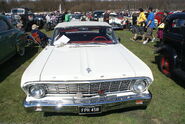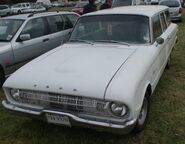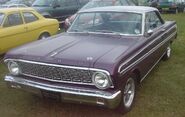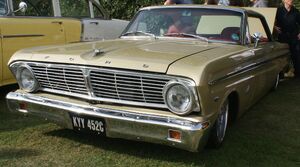
Ford Falcon front view
The Ford Falcon was an automobile produced by Ford Motor Company from 1960 to 1970. It was a huge sales success for Ford initially, handily outselling rival compacts from Chrysler and General Motors introduced at the same time. During its lifespan, the Falcon was offered in a wide range of body styles: two-door and four-door sedans, two and four door station wagons, two door hardtops, convertibles, a sedan delivery and the Ranchero pickup.
First Generation 1960–1963[]
By American standards of the 1960s, the Falcon was a small car, but elsewhere it would be considered a mid-
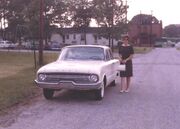
First Generation Ford Falcon Sedan
size car. It was powered by a small, lightweight 90 hp (67 kW), 144 CID (2.4 L) straight-6 with a single-barrel carburetor. Construction was unibody, and suspension was fairly standard; coil springs in front, leaf springs in the rear. Drum brakes were used at the front and rear wheels. A three-speed manual column shift was standard with the two-speed Ford-O-Matic automatic optionally available . There was room for six passengers in reasonable comfort in the simple interior. Body styles available from the launch year were two and four-door sedans, two or four-door station wagons, and the Ranchero car-based pickup, transferred onto the Falcon platform for 1960 from the Fairlane. A Mercury derivative, the Mercury Comet, originally intended for the defunct Edsel marque, was launched in the US midway through the 1960 model year.
The market shift which spurred the development of the Falcon and its competitors also precipitated the demise of several well-established marques in the late-1950s and early-1960s. Besides the infamous tale of the Edsel, the Nash, Hudson, DeSoto and Packard nameplates all disappeared from the marketplace.
In 1960, Ford's Canadian subsidiary introduced the Falcon-based Frontenac. It was designed to give Mercury-Meteor dealers a smaller model to sell, since the Comet was originally intended as an Edsel, which was sold by Ford-Monarch dealers. Produced for the 1960 model year only, the Frontenac was essentially a rebadged 1960 Falcon with its own unique grille, tail lights and external trim, including red maple leaf insignia. Despite strong sales (5% of Ford's total Canadian output), the Frontenac was discontinued and replaced by the Mercury Comet for 1961.
Robert McNamara, a Ford executive who became Ford's president briefly before being offered the job of U.S. Defense Secretary, is regarded by many as "the father of the Falcon". McNamara left Ford shortly after the Falcon's introduction, but his faith in the concept was vindicated with record sales; over half a million sold in the first year and over a million sold by the end of the second year.
The 1961 model year introduced an optional 101 hp, 170 CID (2.8 L) six, and two new models were introduced; a bucket-seat and console sedan model in a higher trim level called the Futura, and a sedan delivery.
Ford boasted of the good fuel economy achieved by six cylinder Ford Falcon models in advertising. The fuel economy was good, compared to other American cars at the time.
The 1962 model year saw a Squire model of the four door station wagon with faux wood trim on the sides. The bucket seat "Futura" model was offered with a slightly upgraded interior, factory installed safety belts, different side trim (spears), and different emblems. Halfway through the model year, Ford changed the roof line at the back window to more of a Thunderbird design and offered a 4-speed transmission for the first time. The 2-door Futura sedan (also referred to as an 'illusion hardtop' because of the chrome trim around the side window opening) sported a flat rear window in place of the panoramic (wrap-around) window on earlier models to bring its design in line with other Ford cars of the era.
In 1963, even more models were available. There was now a 4-door Futura and a Deluxe wagon. Later, convertibles and then hardtops, and the new "Sprint" model were introduced. Halfway through the model year (February 1963), the Fairlane's 164 hp "Challenger" 260 CID (4.3 L) V8 engine was offered for the first time. The Falcon was climbing in trim level from its budget beginnings, as Ford attempted to wring more profit from the line.
Second Generation 1964–1965[]
A redesign changed the Falcon's looks for 1964. The new look was more squared-off, more modern, as Ford pursued the youth market. Later in 1964, Ford's new offering for that market was launched: the Ford Mustang, based heavily on the Falcon's unitized frame design but with no compromises about its youthful, fun intention. For the 1964 year Ford added a Sprint Package which gave the Falcon the 260 V8, a stiffer suspension, and a louder exhaust. Because the Mustang had the same options that the Sprint had for only a small amount more the Sprint never caught on. Even with the addition of the 289 V8 in late 64 the Sprint was overshadowed by the Mustang, and was discontinued after 1965. The Mustang dealt Falcon sales in North America a blow from which they would never recover. Production ended on June 26th of 1965 for convertible Falcons.
From 1965, the three speed Cruise-O-Matic automatic transmission was available.
Third Generation 1966–1970[]
The Falcon received another redesign for 1966, with a long-hood/short-deck look much in the Mustang vein. This body was based on a shortened Fairlane platform with different body sheet metal. The two-door Hardtop and Convertible were dropped, while the Station Wagon and Ranchero were moved to a larger platform shared with the contemporary Fairlane. The Ranchero would leave the Falcon line and adopt the Fairlane's front sheet metal for 1967. The 1966 Falcon was used in the Trans-Am series.
The final model year for the Falcon in North America was 1970. Continuing sales declines and the inability of the car to meet forthcoming safety standards resulted in a short run of 1970 models identical to the 1969 version being built through the end of December, 1969.
1970 Falcon[]
On January 1, 1970, the Falcon name was transferred to a low priced version of the contemporary Ford Fairlane. The new model, which was a sub-series of the Fairlane series, was marketed as the "Falcon '70½" and was available as a two-door sedan, four-door sedan, and four-door wagon. Despite the fact that the Maverick 2-door sedan had been released in April 1969 as a replacement for the soon to be discontinued "compact" Falcon 2-door, Ford went to the trouble of tooling up a unique 2-door sedan for the short '70½ model run. While the number of luxury and convenience options available was limited, the car was available with the full range of Fairlane/Torino powertrains, ranging from the standard 250 cubic-inch six-cylinder and 302 cubic-inch V8 all the way to the 429 Cobra Jet V8.
1970½ Falcon[]
On January 1, 1970, the Falcon name was transferred to a low priced version of the contemporary Ford Fairlane. The new model, which was a sub-series of the Fairlane series, was marketed as the "Falcon '70½" and was available as a two-door sedan, four-door sedan, and four-door wagon. Despite the fact that the Maverick 2-door sedan had been released in April 1969 as a replacement for the soon to be discontinued "compact" Falcon 2-door, Ford went to the trouble of tooling up a unique 2-door sedan for the short '70½ model run. While the number of luxury and convenience options available was limited, the car was available with the full range of Fairlane/Torino powertrains, ranging from the standard 250 cubic-inch six-cylinder and 302 cubic-inch V8 all the way to the 429 Cobra Jet V8.



